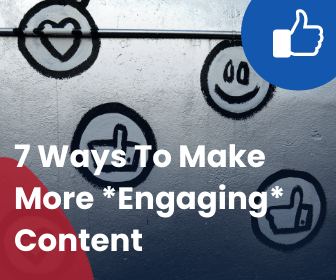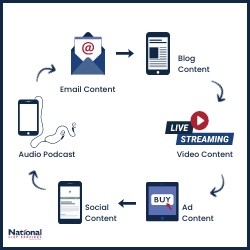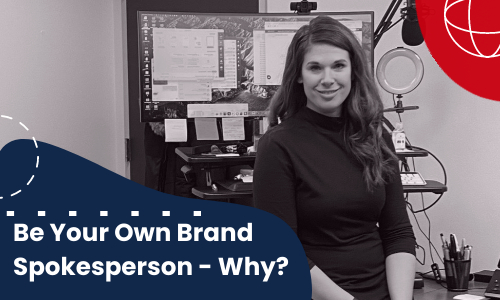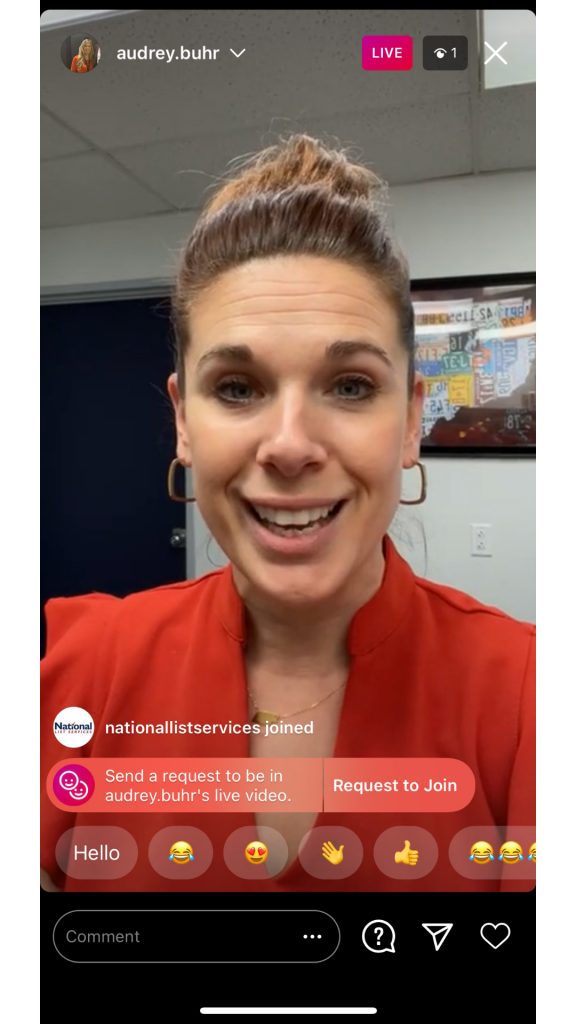7 Ways To Make More Engaging Content

Content creation is an integral part of marketing or running a business in general now. However, a lot of companies struggle with creating content that generates engagement. Part of the value of content creation is that engagement and the conversation between brand and consumer. What can you do to create engaging content for your brand?
Here’s 7 things we have found to be essential in making quality content!
Know Your Audience
The content you create for one audience can be very different from another. Understanding the WHO is helpful first step.
It can also be helpful if you think of your audience as a single composite person. Instead of trying to talk to all of them, you are instead making content for one person. A lot of companies do this by making a buyer persona. That way you can think, “Would my buyer persona like this?” vs. “Would all my followers enjoy this content?”
Make a Plan
There is nothing more overwhelming than trying to maintain consistent content posting across multiple channels without a plan. It can feel like juggling snakes. 🐍 Making a plan can be as simple as figuring out what types of content you want to post and when it would be best to time to post it. The more specific your plan is the more you time you take out of the equation.
Part of making a plan is planning out your message and/or your angle. Now that you know who your audience is, think about what type of content would work best for them. Knowing what you want to talk about can make it easier to figure out what types of content would be best. Would your audience benefit from long form blog articles or would a TikTok series be more helpful? Both of those types of content take a lot of effort, so planning it out ahead of time is valuable!
Find Shared Passions
The sheer amount of product, companies, and information available is staggering. It is not enough anymore to have a good product available anymore, your brand ideals and personality need to match with the personality of your consumers. 56% of Gen Z consumers say that having shared passions and perspectives is a major factor when it comes to their engagement with a brand. However, most consumers are fantastic at sniffing out inauthenticity. Your brand personality and ideals need to actually be what you say they are. Actions speak louder than words!
What are the advantages of having a well-defined brand personality and ideals? Giving your company a personality makes things like content creation a lot easier. Knowing who you are also can help you make decisions about the direction you want to go in the future.
And 49% of young consumers say they will evangelize a brand they feel represents their values, likes, and personality.
Don’t be afraid of incorporating causes you care about into your brands personality! 72% of consumers want the brands they care about to be positive contributors to society. We’ve seen in recent years that many brands (especially smaller companies) connect their core brand to a charity or cause they care about. Younger consumers are 69% more likely to buy from a brand that contributes to a cause.

Keep It Simple
Don’t make it harder than it needs to be. No matter who your audience is, needlessly complicated language or content structure isn’t appreciated. Simple and honest is always good. Remember, why you are making the content. Is it to promote you or your brand? Then tone of the content should match your voice. People can see right through any inauthenticity if you are trying to make something that isn’t you.
It’s easier to connect with a brand online if you feel like you are talking to a real person. Does the content you are making sound personal?
Remember the Big Picture
Why do you want to make this content? Keep the big picture of your content in mind as well as each individual piece. Are you trying to promote a specific product or service? Don’t be afraid to include a call to action in your content! A call to action is how to accomplish the goal of your content. It’s the follow through.
A good call to action is simple and concise. It uses strong verbiage. Give your audience a good reason to take the desired action. Don’t be afraid to get creative!
Take a Step Back
When it comes to content, it’s often valuable to take a step back and from your project and let it rest for a bit. The longer you work on a piece of content the easier it is to be become blind to mistakes, errors, and typos. You may be surprised by the power of fresh eyes!
An old copy writer trick is to proofread backwards. Instead of starting at the beginning of your content: start at the end. Because your brain is following a different path through the information, it sees things in a different way. Starting at the end allows you to look at it sentence by sentence instead of word by word or thought by thought. Knowing your content is edited well will help you feel more confident in posting it.
Another aspect of taking a step back from your content is revisiting old content. Repurposing or adapting finished content is an excellent way to stay inspired and make more content. There are always new things that can be added. Adding information keeps your messages up to date. Up-to-date content is more accurate and provides for value to your followers. Another reason to recycle content is that it gives more people an opportunity to see it. And even if someone has been following you for a long time there’s a good chance that they didn’t see the content the first time around.

Keep Consuming Content
This is my favorite part. 😜 One of the best ways to keep your own content sharp is to consume other content. It can inspire you, help you stay up to date with current trends, and keep your skill sharp. Most ideas don’t start in our heads, the spark is external. All of the creative juices it takes to create content can easily be burnt out if you don’t feed it with creative thing that you care about. Change your scenery, have conversations, read books or articles, watch a movie or show. Diversity of other creative inputs will refill your own creativity!
What type of Content have you found to be the most engaging with your audience?
Be Your Own Brand Spokesperson – Why?

While branding your company most people focus on things like logos, colors, message. Which is all super important! However, in this visual digital world we are living, putting a face to the name (or brand, in this case) is very valuable. For example, pictures with faces in them are on average 38% more likely to get likes and 32% more likely to receive comments.
Here’s some specific reasons to use your face in branding and ways to do so!
Why Showing Your Face Helps Your Business
Here are 4 reasons!

- Using your face helps brand recognition
There’s a reason why brands use spokespeople. It is often easier for people to remember other people than it is to remember brands or companies. - It humanizes your brand
People like to work with people, not “soulless corporations.” Connecting your face to your company makes it easier for customers to relate to you and build an emotional connection. This is one reason why it’s helpful to use your face. Chances are that you and your company share the same values and goals. Having that message come from you and the company reinforces those ideals and helps other care about them too!
Another aspect of humanizing your brand is the trust that comes with it. It’s much easier to trust a person than a company; you know who they are and what they stand for. Linking you to your brand pulls that trust over.
- It creates engagement
Knowing who they are engaging with makes it easier for customer to connect with you on social media. Also, our brains are literally wired to find faces so putting your face front and center will help draw people to your content.
- It helps shape your community
This may sound confusing but linking your face and your brand can help create a more accurate and diverse business community. We all play a part in shaping the communities we are a part of. All of us have a story or journey to share. Highlighting your story along with your company story creates diversity. And you never know who your story will touch!
How to put your face front and center

Here’s some tips to get started
Show behind the scenes
Pull back the curtain on your day to day. Everyone loves behind the scenes. Showing what you are doing is a good way to ease into using your face for marketing. It’s can be simple to do, just bring your audience along to your tasks! It’s a good way for people to get to know you and all the things you. It also can help your customers appreciate all you do!
Use stories!
Stories is a great place to show all those behind-the-scenes shots. It’s also a great place to speak to the camera about your company and your mission. Stories get a lot of engagement but disappear after 24 hours so there’s a lot less pressure! To make it easier on yourself, prerecord your videos. Make “eye contact” with the camera, don’t look at your own face. Have a general idea of what you want to say, a bullet point list helps! And don’t worry about any word whiskers. The point of this is to help people get to know you and show authenticity. It doesn’t have to be perfect!
Go Live!
You might be surprised by how much more engagement live videos get! Unlike prerecorded videos, live streams make viewers feel like they are a part of the conversation. The more authentic interactions create more engagement. For example, on average, live content generates 10x more the comments that prerecorded videos. And people tend to watch live content 10-20x longer.
We want to see your face! How do you connect your personal brand to your company brand?
6 Tips for Effective Content Marketing

According to HubSpot, nearly 70% of business are investing in upping their content production this year. What can you do to make sure your content stands out from the rest?
Here are six steps:
- Figure out what you want to accomplish. Goals are key to any plan. The Content Marketing Institute (CMI) suggests outlining your goals in a formal business plan. It will also be helpful to outline what value you are going to provide your customers with your content and any possible challenges.
- Figure out your audience. Knowing who you want to reach makes it much easier to know what type of content they’ll want to engage with.
- Remember your own branding. What do you want your customers to know about you? What problems can you solve for them? How are you different from your competitors? Knowing what your overarching message will help you choose the right type content and tone.
- Figure out what type of content your audience will respond to. There are so many different types of content, such as blog posts, eBooks, videos, podcasts, webinars, newsletters, etc. However, not all of them will be effective for your audience.
- Keep a schedule. You’ll need a clear plan of attack, especially if different parts of your organization will be involved in content. HubSpot recommends implementing an editorial and a social media calendar. To keep tract of when are where content is going out. Doing so will also help keep your messaging cohesive.
- Keep track of engagement. Keeping track of analytics will help you learn your content’s effectiveness. You can use what you’ve learned about what works or your audience to inform upcoming decisions and make your content continually more effective.
Want more information on how to make your content marketing more effective? Get in touch here.
The Customer Engagement Revolution

Eight months ago, Sales Force surveyed 8,000 customers worldwide to see how customer engagement trends have changed. They found that we were in the middle of engagement revolution. Now, just a few months later, the world is a drastically different place. The “revolution” in how we engage with our customers, has been sped up. We have surged forward to get to where we were already heading.
Sales Force found that a whopping 84% of customers value the experience as much as the product or service. They also found in their research that 73% of customers expectations of quality customer support was increased by just one interaction. Meaning, if another company does something extraordinarily well, customers will begin to expect that level of service from your company.
So, what do the customers want? First, they want you to understand what they need and want, before they ask. How can you do that? Think compassionately and empathetically. For example, what do most people need right now? We know they are mostly stuck at home. They could be scared. Their regular routines are gone, and they are looking for solutions to problems that just appeared and need to be fixed immediately.
Second, customers want you to come to them, on the channel they’re are most comfortable with. It doesn’t really matter what how you prefer to interact with them. And third, customers expect there not to be in missing links in communication within your company. If they talk to a sales rep one day, and customer service the next, they don’t want to have to explain what they need both times. It redundant and feels like a waste of time.
How can your company keep up with the revolution? It’s actually pretty simple: follow the golden rule. Treat your customers the way you would like to be treated by other companies. Think about what they may need, help them with it, and you will be successful.
